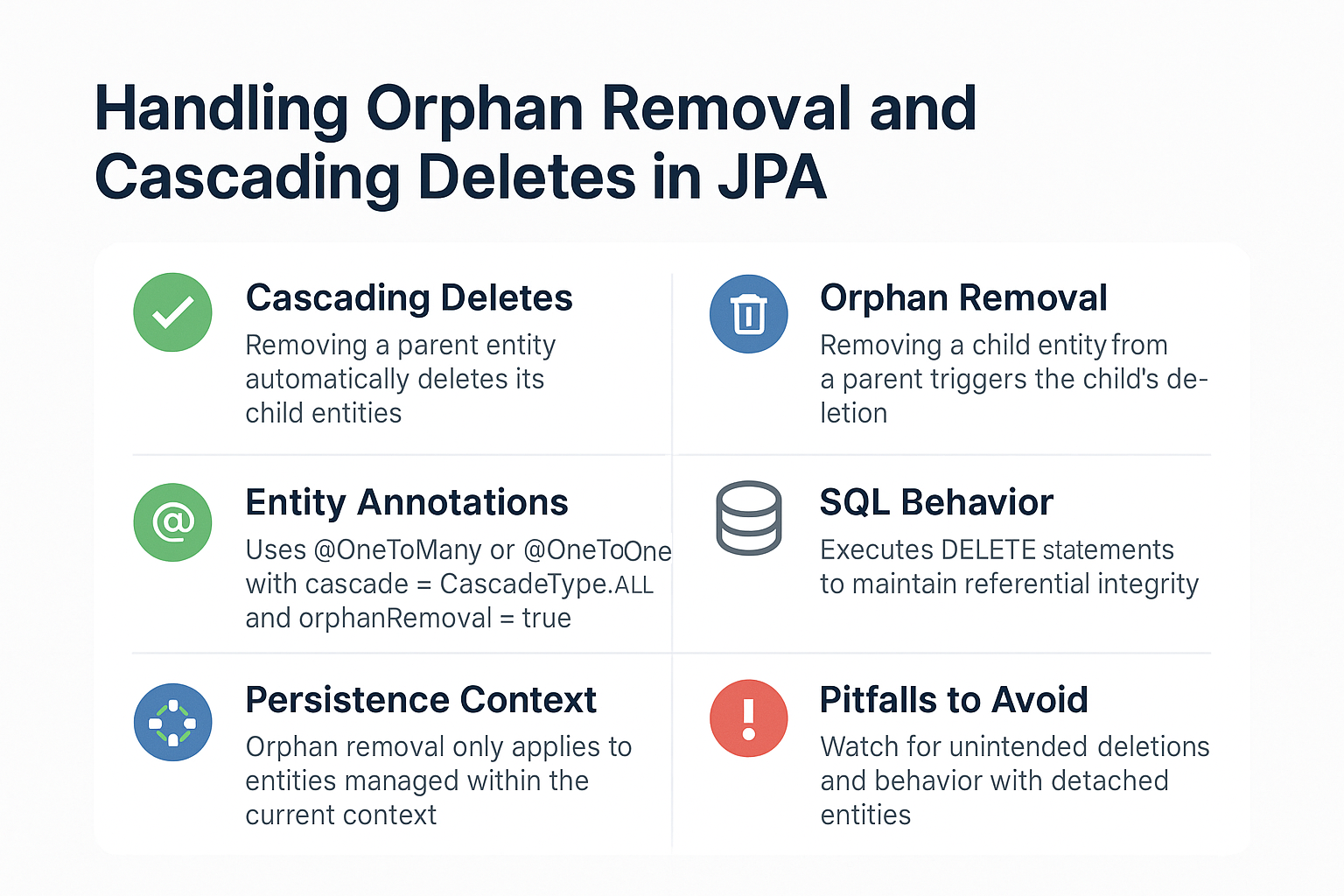In enterprise applications, entities often have parent-child relationships (e.g., Order → OrderItem, Department → Employee). When managing these relationships, two crucial concepts come into play:
- Cascading Deletes: When a parent entity is removed, its child entities should also be deleted automatically.
- Orphan Removal: When a child entity is removed from its parent’s collection, it should also be deleted from the database.
Without these mechanisms, developers must manually delete dependent records, increasing complexity and risking orphaned data. This tutorial will explore orphan removal and cascading deletes in JPA, covering annotations, SQL behavior, pitfalls, and best practices.
1. Core Concepts
Cascading Deletes
Ensures that when you remove a parent entity, all related child entities are automatically deleted.
Orphan Removal
Ensures that if a child entity is removed from a parent’s relationship collection, JPA deletes it from the database.
Analogy:
- Cascade Delete = When a company closes, all employees lose their jobs.
- Orphan Removal = If a department removes an employee from its roster, that employee no longer exists in the system.
2. Example Entity Setup
Parent-Child Entities
import jakarta.persistence.*;
import java.util.ArrayList;
import java.util.List;
@Entity
public class Department {
@Id
@GeneratedValue(strategy = GenerationType.IDENTITY)
private Long id;
private String name;
@OneToMany(mappedBy = "department", cascade = CascadeType.ALL, orphanRemoval = true)
private List<Employee> employees = new ArrayList<>();
// Helper methods
public void addEmployee(Employee e) {
employees.add(e);
e.setDepartment(this);
}
public void removeEmployee(Employee e) {
employees.remove(e);
e.setDepartment(null);
}
}
@Entity
public class Employee {
@Id
@GeneratedValue(strategy = GenerationType.IDENTITY)
private Long id;
private String name;
@ManyToOne
@JoinColumn(name = "department_id")
private Department department;
// getters and setters
}
cascade = CascadeType.ALL: Ensures child lifecycle follows the parent.orphanRemoval = true: Automatically deletes employees removed from the department’s collection.
3. Cascading Delete in Action
EntityManager em = emf.createEntityManager();
em.getTransaction().begin();
Department dept = em.find(Department.class, 1L);
em.remove(dept);
em.getTransaction().commit();
em.close();
SQL Output
DELETE FROM employees WHERE department_id = 1;
DELETE FROM department WHERE id = 1;
4. Orphan Removal in Action
EntityManager em = emf.createEntityManager();
em.getTransaction().begin();
Department dept = em.find(Department.class, 1L);
Employee emp = dept.getEmployees().get(0);
dept.removeEmployee(emp); // Removes child from collection
em.getTransaction().commit();
em.close();
SQL Output
DELETE FROM employees WHERE id = ?;
5. Difference Between Cascade Delete and Orphan Removal
| Feature | Cascade Delete | Orphan Removal |
|---|---|---|
| Trigger | Parent entity removal | Child removed from parent’s collection |
| Use Case | Entire hierarchy removal | Child lifecycle independent of parent |
| SQL Behavior | Deletes all children with parent | Deletes only the removed child |
6. Queries and Persistence Context
When using orphan removal, remember that changes only apply to managed entities in the persistence context. Detached entities won’t trigger automatic deletes unless re-attached with merge().
7. Integration with Spring Boot
@Service
public class DepartmentService {
@PersistenceContext
private EntityManager em;
@Transactional
public void deleteDepartment(Long id) {
Department dept = em.find(Department.class, id);
em.remove(dept); // Cascade delete applies
}
@Transactional
public void removeEmployee(Long deptId, Long empId) {
Department dept = em.find(Department.class, deptId);
Employee emp = dept.getEmployees().stream()
.filter(e -> e.getId().equals(empId))
.findFirst().orElseThrow();
dept.removeEmployee(emp); // Orphan removal applies
}
}
8. Performance Considerations
- CascadeType.ALL may propagate unintended deletes — use carefully.
- OrphanRemoval is powerful but only applies to
@OneToOneand@OneToMany. - Avoid deep cascade chains that may trigger large delete operations.
- Always profile SQL logs when testing cascade and orphan behavior.
9. Pitfalls and Anti-Patterns
- Forgetting orphanRemoval: Simply removing a child from a collection won’t delete it unless
orphanRemoval = true. - Detached Entities: Orphan removal doesn’t apply outside persistence context.
- Overusing CascadeType.ALL: May unintentionally delete unrelated entities.
- Eager Fetching: Leads to performance bottlenecks in large parent-child hierarchies.
10. Best Practices
- Use orphanRemoval = true for child entities fully dependent on parents.
- Prefer CascadeType.PERSIST, REMOVE selectively instead of
ALL. - Keep relationships unidirectional unless bidirectional is necessary.
- Write unit tests for delete cascades to prevent accidental mass deletions.
📌 JPA Version Notes
- JPA 2.0: Introduced
orphanRemovalfor better child lifecycle management. - JPA 2.1: Improved cascading operations with entity graphs and stored procedures.
- Jakarta Persistence (EE 9/10/11): Migration from
javax.persistence→jakarta.persistence. No breaking changes for cascade/orphan, but package updates required.
Conclusion and Key Takeaways
- Cascading Deletes remove child entities when the parent is deleted.
- Orphan Removal deletes children removed from collections.
- Together, they simplify entity lifecycle management and prevent orphaned data.
- Always test delete operations carefully to avoid unintended data loss.
FAQ (Expert-Level)
Q1: What’s the difference between JPA and Hibernate?
A: JPA is a specification, while Hibernate is an implementation with extra features.
Q2: How does JPA handle the persistence context?
A: It manages entities in memory, tracks changes, and synchronizes them with the database.
Q3: What are the drawbacks of eager fetching in JPA?
A: It loads unnecessary child data upfront, impacting performance.
Q4: How can I solve the N+1 select problem with JPA?
A: Use JOIN FETCH, batch fetching, or @EntityGraph.
Q5: Can I use JPA without Hibernate?
A: Yes, other providers like EclipseLink and OpenJPA also implement JPA.
Q6: Can orphanRemoval be used with @ManyToMany?
A: No, it only applies to @OneToOne and @OneToMany associations.
Q7: What happens if I set cascade=REMOVE but no orphanRemoval?
A: Children will be deleted when the parent is removed, but not when removed from the collection.
Q8: How do I prevent accidental cascading deletes?
A: Use targeted cascade types and avoid CascadeType.ALL unless necessary.
Q9: Is JPA suitable for microservices?
A: Yes, but sometimes lightweight SQL mappers like jOOQ or MyBatis may fit better.
Q10: When should I avoid JPA orphanRemoval?
A: Avoid it if child entities must exist independently or have shared relationships.
